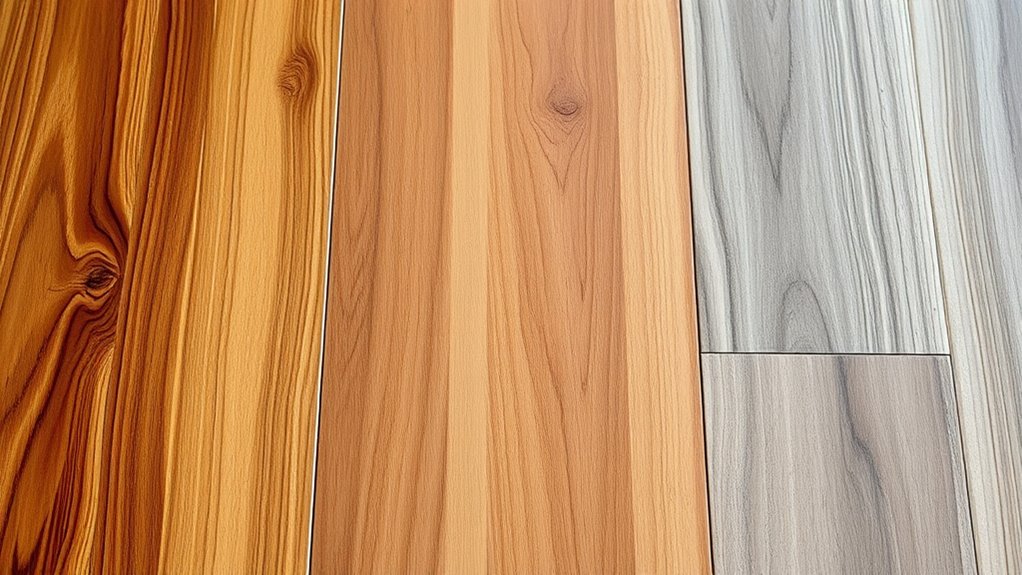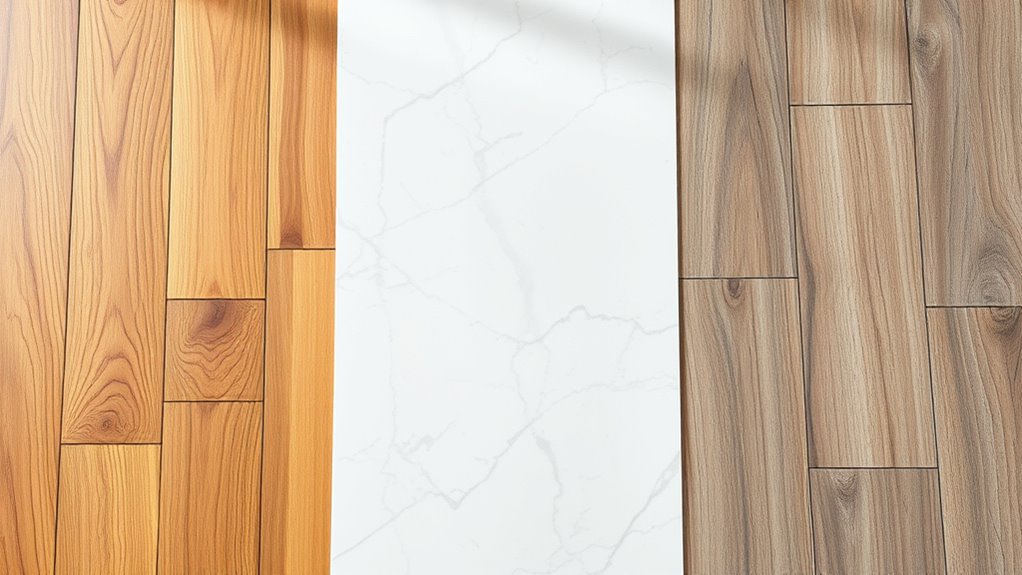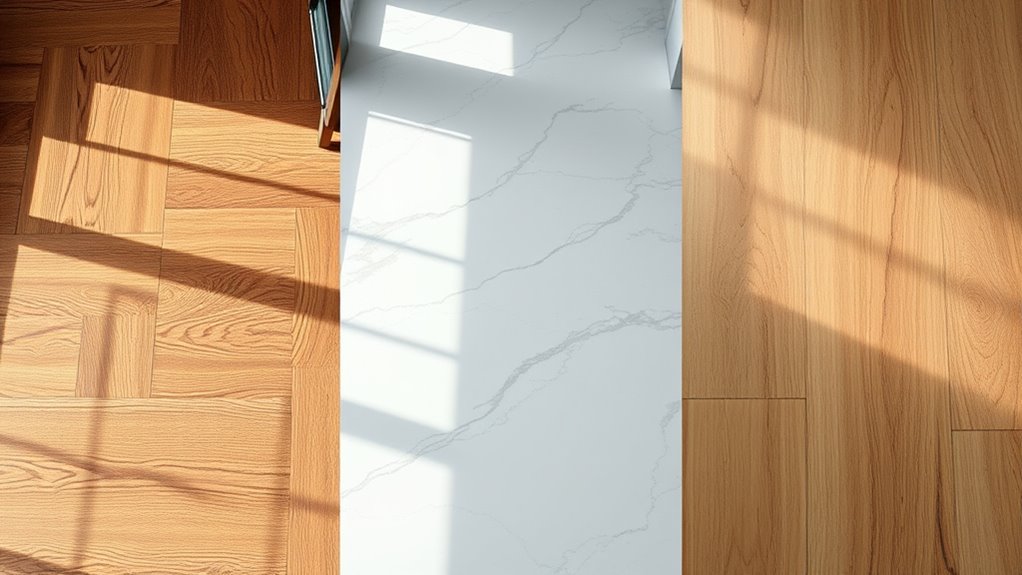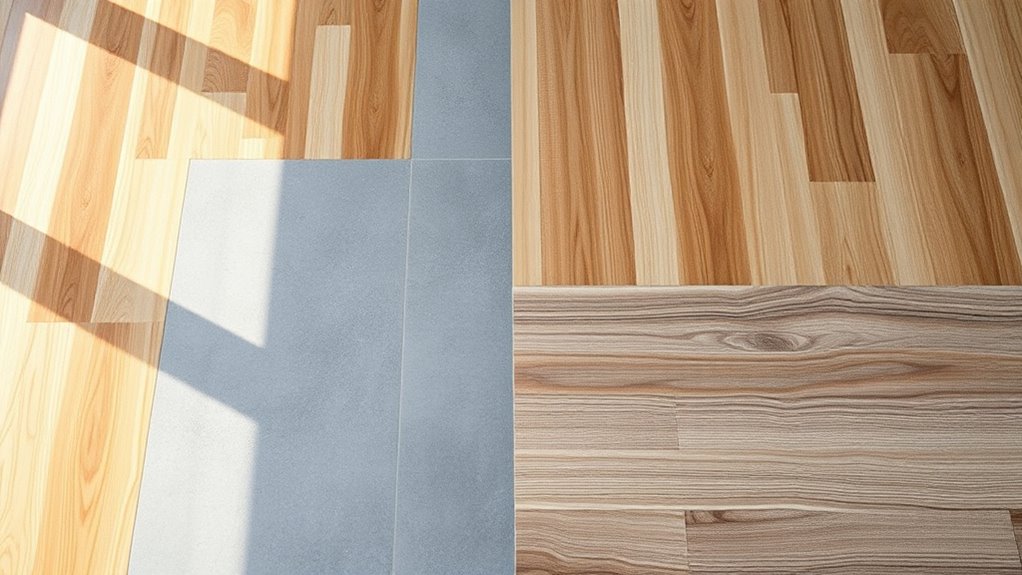Choosing between hardwood, vinyl, and laminate flooring depends on your lifestyle and style preferences. Hardwood offers timeless beauty but needs regular maintenance and can be pricey. Vinyl is budget-friendly, easy to install, and handles moisture well, making it ideal for busy or moisture-prone areas. Laminate balances affordability and durability but requires careful upkeep. To find the perfect fit, consider your needs, budget, and design goals—more details will guide your decision.
Key Takeaways
- Hardwood offers a natural, classic look but requires more maintenance and higher upfront cost.
- Vinyl is highly moisture-resistant, easy to install, and budget-friendly, ideal for DIY projects.
- Laminate provides a durable, cost-effective alternative with simpler installation but is more susceptible to water damage.
- Consider lifestyle factors like pets and high traffic when choosing between materials for durability and stain resistance.
- Match your aesthetic preference—hardwood for timeless elegance, vinyl and laminate for versatility and modern styles.
Comparing Materials: Hardwood, Vinyl, and Laminate

Have you ever wondered which flooring material is the best fit for your space? When comparing hardwood, vinyl, and laminate, installation challenges and maintenance requirements are key factors. Hardwood offers a classic look but can be tricky to install, especially in areas prone to moisture, and needs regular refinishing to maintain its beauty. Vinyl is easier to install, often as a DIY project, and handles moisture well, making maintenance simple—just regular cleaning. Laminate provides a cost-effective alternative with straightforward installation, but it can be susceptible to water damage and scratches, requiring careful maintenance. Understanding these differences helps you determine which material aligns with your lifestyle, budget, and ability to handle installation and upkeep. Additionally, considering the material’s durability can influence long-term satisfaction and overall value.
Factors to Consider When Choosing Flooring

Choosing the right flooring depends on several important factors that influence both the look and functionality of your space. First, consider cost considerations—your budget will guide whether hardwood, vinyl, or laminate fits best. Hardwood tends to be more expensive upfront but offers lasting beauty, while vinyl and laminate options are often more budget-friendly. Next, think about maintenance requirements. If you prefer low-maintenance flooring, vinyl and laminate are easier to clean and resistant to stains, whereas hardwood may need regular refinishing and specific cleaning products. Also, evaluate durability based on foot traffic and wear. Additionally, the aesthetic appeal of each material can significantly affect the overall ambiance of your room, especially in styles like farmhouse bedrooms where natural textures and warm tones are preferred. By weighing these factors, you’ll better understand which flooring material aligns with your style, lifestyle, and financial plan, ensuring a choice that suits both your space and your needs.
Making the Final Decision: Which Flooring Suits Your Lifestyle

Ultimately, selecting the right flooring hinges on how well it fits your lifestyle. If you have pets, look for pet-friendly options that resist scratches and are easy to clean. Families with children benefit from durable, low-maintenance materials that can handle wear and spills. Eco-friendly materials, like bamboo or cork, appeal if sustainability matters to you. Consider your daily routines—if you cook often, choose flooring that’s resistant to moisture and stains. If you prefer a cozy feel, laminate or hardwood might be best, but if you want easy upkeep, vinyl could be ideal. Assess your priorities—whether durability, eco-friendliness, or comfort—and match them to the flooring type that aligns with your lifestyle for a satisfying, long-term choice. Infidelity cases can sometimes be uncovered through careful observation of daily habits and environment, highlighting the importance of choosing a flooring material that supports a peaceful, trustworthy home.
Frequently Asked Questions
Which Flooring Options Are Most Eco-Friendly?
If you’re looking for eco-friendly flooring options, focus on sustainable sourcing, recyclability, and disposal. You might consider bamboo or cork, which grow quickly and are renewable. Linoleum made from natural materials is also a good choice because it’s biodegradable and easy to recycle. Avoid flooring with harmful chemicals or non-recyclable components. By choosing sustainable and recyclable options, you reduce environmental impact and make a greener choice for your home.
How Does Each Flooring Type Affect Indoor Air Quality?
Many believe flooring doesn’t impact indoor air quality, but VOC emissions tell a different story. Hardwood floors usually emit fewer VOCs, reducing air pollution, while vinyl can release more harmful chemicals over time. Laminate flooring may trap allergens, leading to increased allergen accumulation. You should choose a flooring type that minimizes VOC emissions and allergen buildup to keep your indoor air healthier and safer.
Are There Specific Flooring Choices Recommended for Allergy Sufferers?
If you’re allergy sufferers, you should look for allergy-friendly materials and hypoallergenic flooring options. Opt for hard surfaces like hardwood, tile, or vinyl, which don’t trap allergens like dust or pet dander. Avoid carpets or rugs, as they tend to harbor allergens. Choosing these hypoallergenic flooring options can help reduce allergy symptoms, improve indoor air quality, and create a healthier living environment for you.
What Are the Typical Installation Timeframes for Each Flooring Type?
When considering installation duration, hardwood usually takes about 1-3 days depending on the project size, fitting into your renovation timeline smoothly. Vinyl flooring installs quickly, often in a single day, making it ideal for faster updates. Laminate flooring also installs quickly, typically within one to two days. Your choice depends on how quickly you want the project done and how it fits into your overall renovation schedule.
How Do Maintenance Requirements Differ Among Hardwood, Vinyl, and Laminate?
You’ll find that maintenance routines vary for each flooring type. Hardwood needs regular cleaning with damp cloths and occasional refinishing, while vinyl is low-maintenance, requiring simple sweeping and mopping. Laminate floors also need gentle cleaning to prevent damage but are more resistant to scratches. Repair procedures differ too—hardwood can be sanded or refinished, whereas vinyl and laminate often require replacement of damaged planks or sections.
Conclusion
Think of choosing your flooring as selecting the perfect path through a forest. Hardwood is like a sturdy, timeless trail that ages beautifully, while vinyl is a flexible, easy-to-maintain path that adapts to your needs. Laminate offers a cost-effective route with a quick upgrade. Whichever trail you pick, make sure it aligns with your journey—your lifestyle—so every step feels right and leads you home comfortably.









